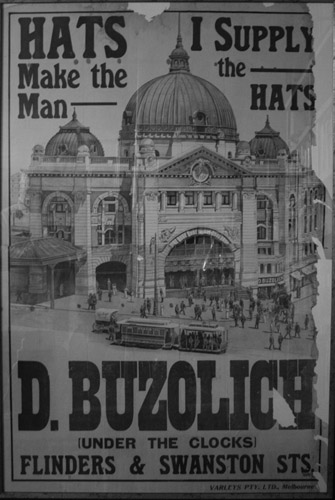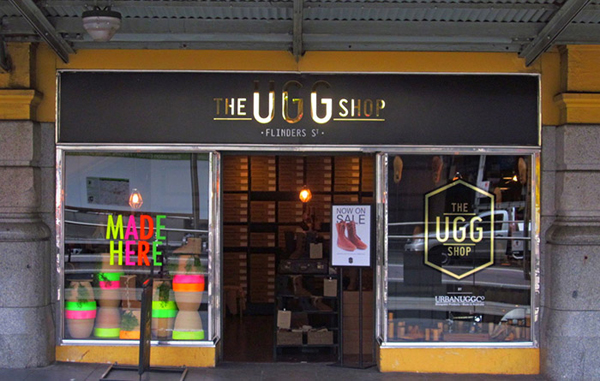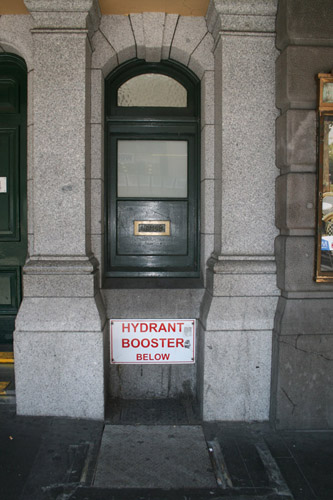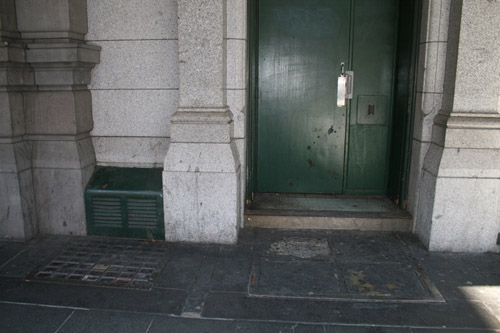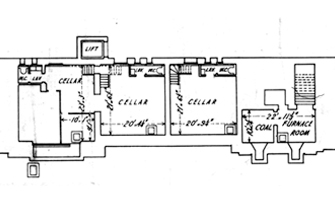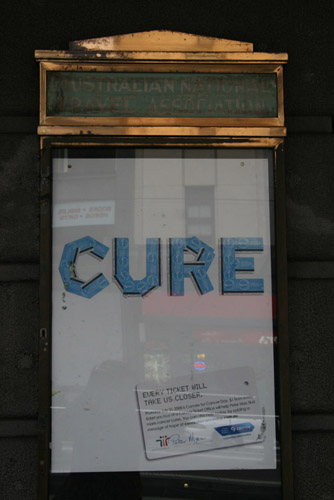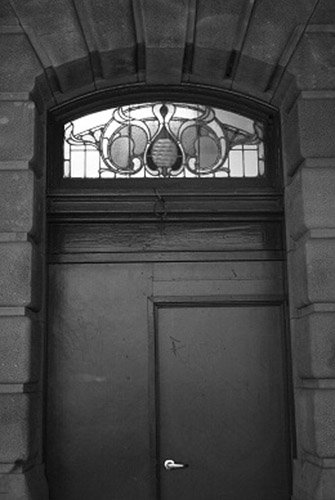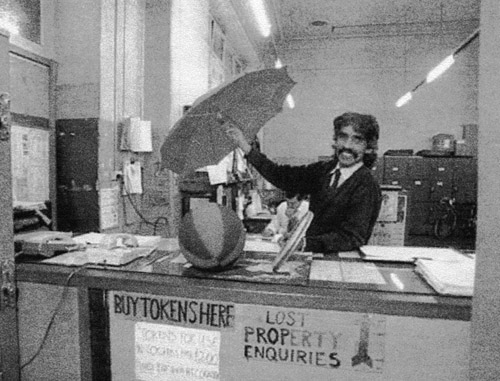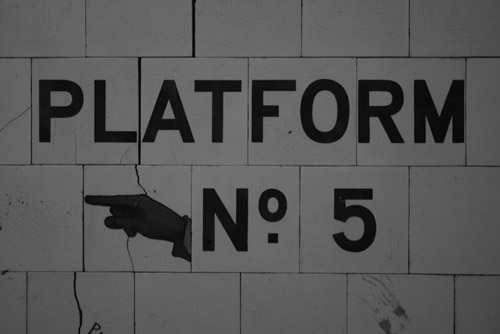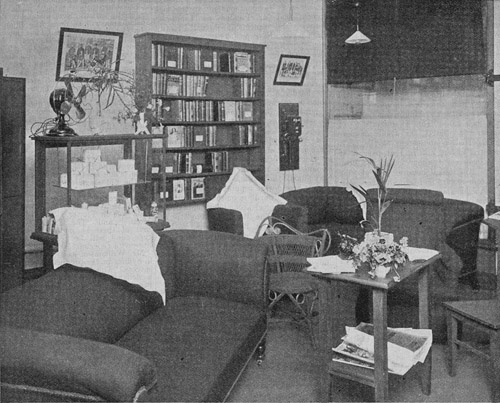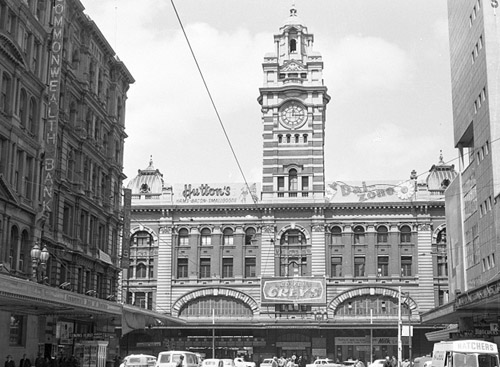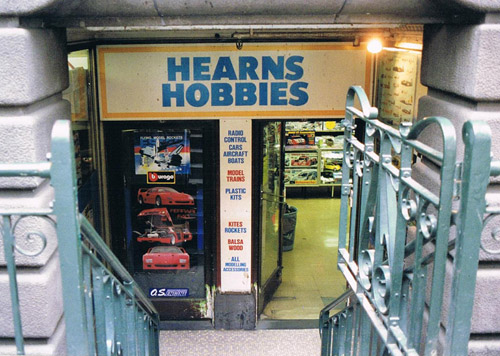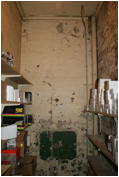STREET LEVEL / SUBWAY / BASEMENT: STORIES
The Buzolich Hatters
Buzolich poster used on the opening of the first hat shop in 1910
|
My father, Frank Buzolich, was the second son of my grandfather who pioneered the family name in hats. Dad died in 1938 when I was 15 and left the hat shops in the city to my mother. In a pre-1930 arrangement with creditors he had acquired the shop at Lt Collins Street and he expanded the business to five shops before his death. My grandfather was Nigel Dugald, known as Douglas. After 30 years as a successful businessman, Douglas was a leading citizen who, in addition to many important civic duties, had been the honorary secretary of a citizens’ group to oversee the celebrations connected with the opening of Federal Parliament in May 1901 by the Duke of Cornwall and York. Before Douglas acquired the station shop ‘under the clocks’ in 1910, he ran a hat shop at 17 Elizabeth Street. 1n 1911 he acquired a shop at 277 Lt Collins St and closed Elizabeth St during the Great War. The acquisition of the station shop enabled him to employ his 20 year old son, Doug, and devote more time to civic affairs. The other sons, Jack and Bill, worked as assistants to Doug in the station shop but lost whatever place they had in the business when that shop was taken over by a major creditor in 1932. When Douglas died in 1916 his eldest son, Doug, a captain in the army, was brought home to manage the business for his mother. In 1919, Frank, my father, was discharged from the army and undertook the management of 277 Lt Collins St. My father used the slogan, “Buzolich’s -hatters since 1880”. From 1931 to 1936 he conducted a dynamic expansion of the business by introducing a range of narrow brimmed hats which he promoted as “styles of tomorrow”. With advertising flare, Frank made Buzolich’s a household name through promotions on the radio, by film at the cinema and also ads in the Football Record during the season. It should be recorded that Uncle Bill, the youngest of my uncles, established a successful hat shop in Geelong. Uncle Jack was employed by my father and became the general manager of the 5 shops after my father’s death. The 2 shops in Swanston St were closed during WWII. In 1946 another shop was opened in Swanston St and in 1948 a shop was opened in the station basement at 295 Flinders Street. During WWII, Uncle Doug was an inspector of military hat wear. I started an apprenticeship with United Felt Hats (manufacturers of Fayrefield Hats) in 1940, 2 years after my father’s death. I kept the books for the Buzolich business and worked around the factory in clerical jobs that gave me an insight into a business that ran effectively but which, like Buzolich’s, was destined within 30 years to go out of business because of the impact of motor cars on the wearing of hats.... After war service with the 2nd A.I.F., I established a small accountancy practice which enabled me to serve my mother’s company as director and secretary which led to a career with large industrial and mining conglomerates. |
Made for the Job
Manager Bill Littlehales who worked here for 45 years and was manager for 25 years
|
Bill Littlehales worked at the City Hatters for 45 years. He was manager for 25. His son Ian says that he was always immaculately dressed and was made for the job. Bill started as a xx year old, was given time off to go to war and promised his job back when he returned. The owner, Henry Buck, honoured this promise and Bill was made manager in 19xx. The safe in the shop contain ledgers that Bill kept which not only recorded the daily takings but also recorded the weather details. The correlation between various weather conditions and hat sales was clearly evident. You did not, for instance, sell many hats on windy days nor did you sell felt hats on hot days. None of this is surprising really but to have this detail recorded is very valuable. An old neighbour of Bill’s from Cheltenham who was present at a talk in 2010 at the Clayton RSL commented that Bill must have parted his hair with a theodolite it was so straight.
|
The Shops beside the Hatters
Shop 2 is currenlty leased by The Ugg Shop
|
In 1910, Shop 2 was leased to the Lucas Brothers, fruiters and confectioners. A letter from John Lucas to the railways secretary in December 1910 lodged a complaint that his business was being tampered with because the lessee of the refreshment rooms was exhibiting fruit. In 1910, Shop 3 was leased to Henry Turner, a fishmonger, who simply called his business Turners. Turner was gone by 1912 and the Lucas Brothers expanded their business into Shop 3. Lucas Brothers continued to operate as a fruiter and confectioner until 1958 when they changed the nature of their business to that of a café. In 1959 Dependable Shoe Repairs shared the space with Lucas Café in until 1968. A tobacconist also moved into Shop 3 in 1966. Lucas café operated until 1968. The wall between Shops 2 & 3 may have been removed by the Lucas Bros when they expanded their business in 1912 or more likely when they changed the nature of their business to that of a café in 1958. Various businesses operated from these two shops until the 1980s when a delicatessen was opened. Between The wall between Shops 2 & 3 has been replaced and Shop 2 is now occupied by The Ugg Company and Shop 3 is still a tobacconist, now Cignall. In 1911, Shop 4 was leased to George Manders, luggage and leather goods which traded here until 1931. Manders was replaced by Paltars (Dyers) which became a dry cleaners in 1938 and continued to operate until 1962 when it was replaced by Bancroft’s Dry Cleaning then Top Four Dry Cleaners in 1968 and subsequently replaced in 1977 by Spotless Retail P/L. In 1965, the hairdresser Constantino, also ran a business in Shop 4 until after 1974. This shop is still a hairdresser.
|
The Cellars
Evidence of the cellar chutes along Flinders Street
Evidence of coal chutes at the 273 Entrance
|
The three shops next to the hat shop all have ‘cellars’. The cellars under Shops 2 and 3 had an opening between them and were accessed from Shop 3. The cellars contained a toilet and wash basin as well as storage space. Shop 4 had its own cellar. City Hatters still has its own toilet and washroom with a small window that opens onto Platform 1. During the time of steam engines, the soot and smoke would filter into the shop if the window was not closed. In more recent times, various unsavoury odours may still filter in if the window is left open.
The Estate Rent Books indicate that these cellars were rented out at various times. The cellar under Shop 4 is still in use by the hairdresser. The windows that opened onto Platform 1 have been covered in for privacy. The other cellars are no longer accessible from Shop 3. The basement area under the entrance at 223 Flinders Street contained a coal storage area and a furnace room which was used to heat the water of the hydronic heating system for the building. It would seem from the building drawings of 1930 that the coal was delivered via chutes that existed along Flinders Street. Furnaces with coal storage areas also existed in the basement west of the Degraves Street entrance abutting what were originally four shops, later to become the basement cafe. Cellars also existed beside the foundations of the clock tower. Batteries that were used to power the electric lights in the building were also located in a separate room located here. Beside these rooms were the furnace and coal rooms though it would seem that the coal was delivered via a lift from Platform 1. The shops at the western end of the building are in the cellars or basement. Originally there were five shops, each with their own toilet and washroom facilities. Now that the space is all one shop, there is just one operating toilet and washroom. The other spaces are used as an office and as storage.
|
The ANTA
ANTA boards are still in place on either side of the entrance
|
The Australian National Travel Association was formed in 1922 with the charter to ‘put Australia on the map and keep it there’. The Chairman was the Chief Commissioner, Harold Clapp. The offices were on the 2nd Floor, rooms 46 to 48. Rental records: For a brief period the name was changed to the Australian National Publicity Association. The original notice boards still exist beside the entrance at 223 Flinders Street.
|
The VRI Office
The VRI entrance on Flinders Street
|
The Victorian Railways Institute office has returned to Flinders Street Station and occupies the large room on street level that was previously used as the Lost Property Office. There is a sign beside their security door that this office is no longer the Lost Property office. The VRI discussed their possible move from the station for many years. The fact that the facilities such as the library, billiards room, gym and ballroom were in a very poor state of repair and that there was no funding available for the refurbishment and maintenance of what had once been outstanding facilities. The VRI agonised over what seemed an inevitable move, finally closing the gym and sauna in December 1984 and making their move to level 11 King’s Car Park, Flinders Lane soon after. At their new location, a modern gymnasium was established and opened in March 1986 on the same floor as the office. There were no library facilities and the books from the station library were all auctioned off. The VRI AGM (1985) President’s Report states that, “The VRI Council continues to be seriously concerned over the condition of the VRI Ballroom and floor. Despite a number of discussions, exchanges of correspondence and personal representation, no action has been taken to relieve our concern with the general condition of the ballroom. It is apparent that unless this matter is resolved in the near future, because of the unsafe condition and the risk of more accidents involving claims, it will be necessary for the ballroom to be no longer available for the conduct of any activity arranged by or through the Institute. The VRI Office has since moved back into the station. They no longer have the facilities that they used to and have no responsibility for the original facilities that existed on the 3rd floor. They promote themselves as the Victorian Recreational Institute and offer services to members such as accommodation venues throughout Australia, theatre and entertainment bookings and discounts on a variety of services. Membership is open to anyone. |
Lost Property in the 1970s
VRI office was once the Lost Property & Cloak room
|
This photo was taken in 1995. I had already been there a few years. Lost Property was on the ground floor just to the east of the main entrance at 273 Flinders Street. We were always very busy as the lost property from all the suburban stations also ended up with us if it wasn’t claimed fairly quickly from the other stations. We also handled all the lost property from the trams. People lost all kinds of things but the most common were wallets, bags and umbrellas. You had to show some kind of ID to get your goods back. Organising umbrellas was quite difficult as there were always so many. Even bikes would be handed in. If a wallet was handed in that contained money, the money was removed and receipted and the person that handed it in could claim it after 3 months if the owner didn’t appear. After 3 months in fact, all the lost property would be put in a hamper and sent to Spotswood where the goods would be auctioned. The auctions were advertised in the papers. These auctions continued till well into the 1990s. |
Tiles from ‘The Tess’
Detailed view of a heritage listed platform hand sign
|
Minnie Florence Williams used to tell her grandson as a small boy that ‘we made those tiles’ as they walked past the Do Not Spit signs on the station ramps. Although Minnie was not actually employed at The Tess until 1915, about 10 years after the tiles would have been supplied to the station, she was very proud to have worked at the company. As the wall signs and pointing hands had been stencilled on by the Victorian Railways sign writers, it is likely that just the glazed tiles were supplied. The Australian Tessellated Tile Company (The Tess) was situated next to the railway line in Mitcham and the clay was obtained from various quarries in the area. They had specialized in glazed ceramic bricks and tiles since their establishment in 1885. The Company introduced the manufacture of dry-pressed tiles known as ‘dust’ tiles which became the company’s major product for many years. |
The Loungers’ Club
1909 Loungers Club
|
The following is an extract from Australasian Dec 26 1909. ‘Miss Gunn’s idea is to provide a rest-room for tired shoppers, students and others who have an otherwise unoccupied hour or so to spend in the city. The daily papers and newest magazines are provided, and for the modest sum of one penny anyone can take advantage of a paper and an easy chair. Afternoon tea is obtainable, and as the club is kept open until after 8 o’clock every evening, it ought to be an inestimable boon, especially to business girls and clerks who wish to go to a theatre or some other entertainment without the tiring rush of going home and to the city again. A toilet-table is provided and the possibility of being able to change one’s blouse and “do” one’s hair ought to be appreciated by hundreds of women. A club of this kind really appeals to girls more than anyone else, for up until now there has been absolutely no place of this kind for their convenience. In addition to the comforts for the ordinary customers, there is an up-to-date library, supplied with the newest literature, and those who are annual subscribers to the club will be allowed to take books home. The club is connected to the Telephone Exchange on the main system.’
|
A Giant Neon Sign on the Roof
A 1950s view down Elizabeth St showing the advertising on the station
|
In the 1950s and 60s my grandparents, David and Ann Gough, had a very successful family disinfectant/antiseptic business in Melbourne. They had strong Glasgow accents having immigrated in 1948. There products were promoted on Channel 9 by Graham Kennedy and Nancy Lee, with Graham Kennedy doing some live ads for at least one product, Gough’s Lavender, on In Melbourne Tonight. They also had ads on Melbourne 3UZ Radio with my grandfather having a long talk slot. The products included Dai-Zone, Gough’s Lavender, Perfectant, Nylozone, Pinefume and Gough’s Silicone Car Polish. One product, Dai-Zone ‘for a stain free, daisy fresh wash’, had a large moving neon sign above the Elizabeth Street entrance to the station, which I believe had petals coming off a large daisy flower (there from about 1955-58). It was fantastic to see a photo of this in your book. Any further information would be greatly appreciated! |
The Western Basement
Original Entrance to the western basement shops 295 & 297
|
The western basement was in fact built as 5 shops available for rent. They had a variety of tenants over the years and were well placed for the convenience of commuters. Hearns Hobbies (HH Wholesalers P/L) moved into shop 5 (303 Flinders Street) in 1964. In 1967 they moved into shop 1 (295 Flinders Street) and progressively occupied all 5 shops. Arches were created between the shops so that it became one connected shop. You can still see the original shop numbers above the entrances. The entrance to shops 1 & 2 (295 and 297) is now the only entrance to the current Hearns Hobbies. There is a locked gate at the top of the stairs to the second entrance which was to shops 3, 4 & 5. The street numbers and the original door are still in place. As 5 separate basement shops, all had toilets and washrooms. Only one of these is still operational and the other spaces are used as storage or office space.
Does anyone have a story about any of the other tenants? If so share your story with us!
|

